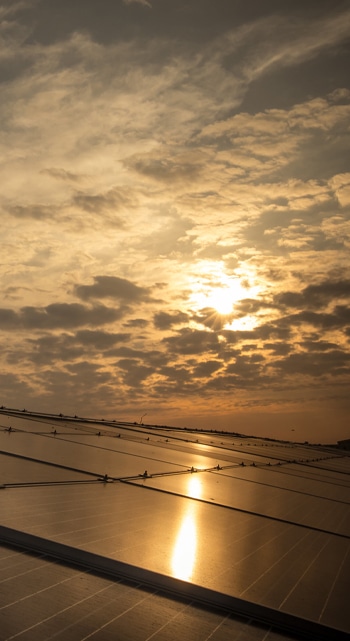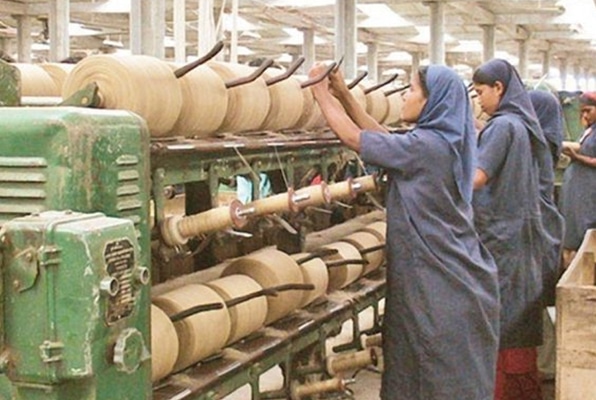For the last five or six decades, India’s jute sector has been a key contributor to the country’s economic development. The jute industry still occupies an important place in the national economy of India. Eastern India, notably West Bengal and Orissa, where the golden fiber meets all of the requisite meteorological conditions and amenities for safe jute
manufacturing.
This industry has long provided employment for local workers, not only because of its economic benefits. Jute is an environmentally friendly, biodegradable product, used for packaging, decoration, industrial usage and for other daily purpose items.
Tossa (Corchorus Olitorius) and white jute are the most common jute kinds in India (Corchorus Capsularis). The market value of the jute bag industry alone will be worth around or more than Rs. 2,32,45,11,00,000.00 in the year of 2024. The expected CAGR of the global jute industry is around 8.94% during the years 2022-2027.
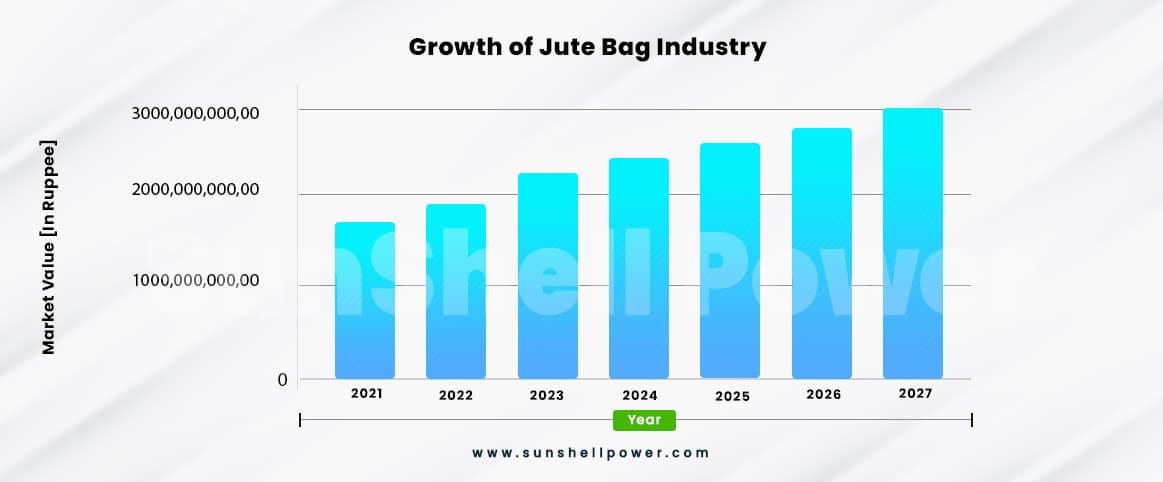
In Eastern India, there are around 79 composite jute mills, with 70 of them located in West Bengal alone. However, India’s central government owns just six jute mills, while state governments hold four and cooperatives own two.
Not only production India also exports jute products mainly jute bags. In the financial year of 2020-2021, India has exported jute bags worth 100.36 million USD.
In this world where pollution has become a major issue, jute bags and jute materials are the most sustainable and green product to use.
However, the exponential emergence of plastic as a low-cost alternative has wreaked havoc on the current sector. However, owing to a sharp increase in global pollution and huge public awareness efforts, people are beginning to return to the usage of jute and other sustainable
materials. In these circumstances, the industry’s expansion is unavoidable.
Even if the business has enormous potential in the future, events such as mass layoffs and the closure of the majority of jute mills have become a regular portrayal of the industry. So, in truth, there are underlying issues that are slowly but steadily eroding the industry’s potential
development.
To dive deep into the problems of the industry we must first know how the production happens and about the machineries used.
Components & Working Process of Jute Mills:
Actually the process of extracting jute fiber from the actual tree is done mainly by hand and usually the farmers do the entire extraction process.
- Growing & Harvesting of Jute: Jute fibers are extracted from growing long jute stems. Jute cultivation is best suited to warm, humid conditions with enough water and water storage. The plants begin to thin out when they reach around 17-20 feet tall. That’s when the plants, which are wrapped into bundles, are buried in water for roughly 20 days. The jute threads and tissues are softened as a result of this procedure. Separation of the fiber occurs. The threads are split by hand after appropriate retting, and the fibers are hung to dry on bamboo poles.
This jute fiber acts as the raw material for any jute related product.
- Procurement of Raw Materials: The raw materials are usually procured from the village farmers at a low-budget rate.After then they are loaded into trucks and headed towards the jute mills for further processing. The basic and most popular jute product is bags made out of jute. Now, we will look at how a jute bag is being manufactured.
- Production of Jute Bags: The process of making jute bags is carried with great precision and accuracy. Only highly skilled craftsmanship can do this entire process.
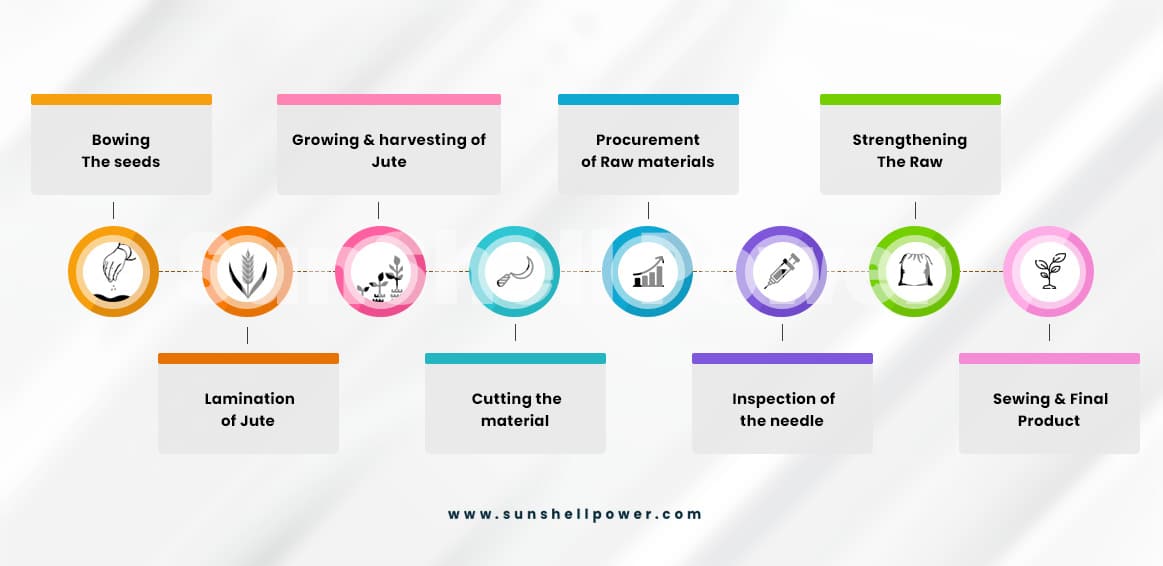
- Strengthening The Raw Material: After fetching raw materials, they are spawned into yarn. These fibers are then processed with many chemical procedures to enhance their properties. The further processed jute is then made resistant to fire and water throughout this process. These processed jute strands are then woven into various types of jute fabrics like white jute, tossa jute and jute cuttings.
- Lamination of Jute: Then the strands are woven by various machines, running on electricity. These woven fibers are then laminated with LDPE lamination. The lamination adds properties like high strength in low temperature, better adaptability of the material in different circumstances etc.
- Cutting of The Material: The fabrics are then dyed and sent out to the cutting department where by the help of machines, these fabrics are cut into precise sizes to create different patterns or designs according to the need of the customer.
- Sewing & Final Product: After each piece is cut into precise sizes and proportion, the pieces are then sewed and the final product is then supplied to the inventories.
Machineries Used in Jute Mills:
- Jute Spinning Machines
- Jute Loom
- Jute Spreader Machine
- Jute Beaming Machine
- Jute Weaving Machine
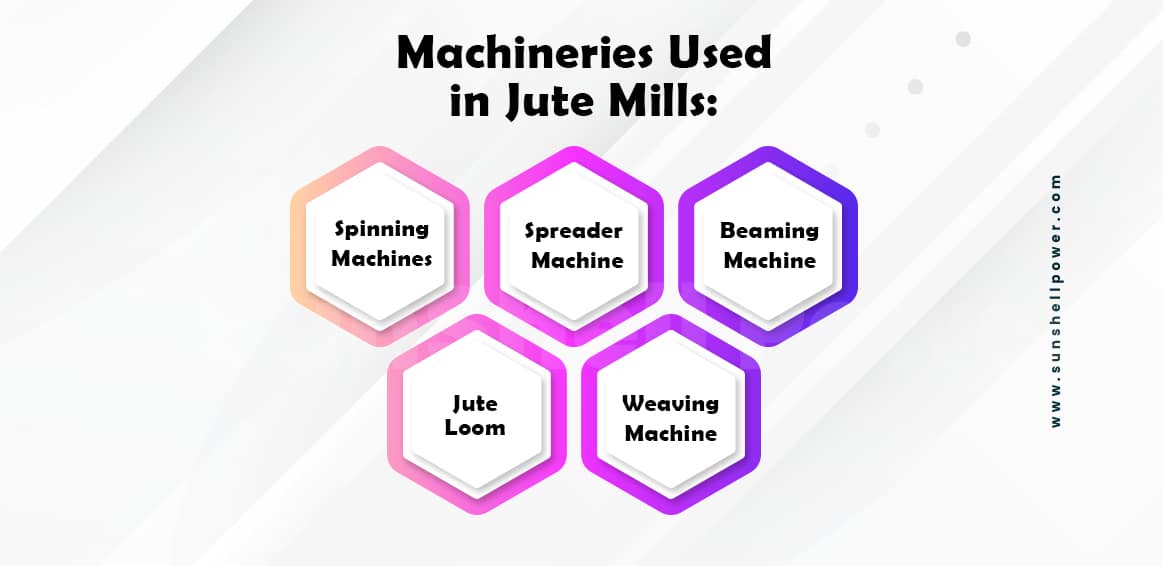
Electrical Load:
The electrical consumption of a jute mill is highly influenced by the major two departments of a jute mill i.e. spinning & weaving. The share of electrical consumption of these departments are 37.75% and 19.04% per day respectively. The breakdown of electrical consumption of the departments in jute mill are as following:
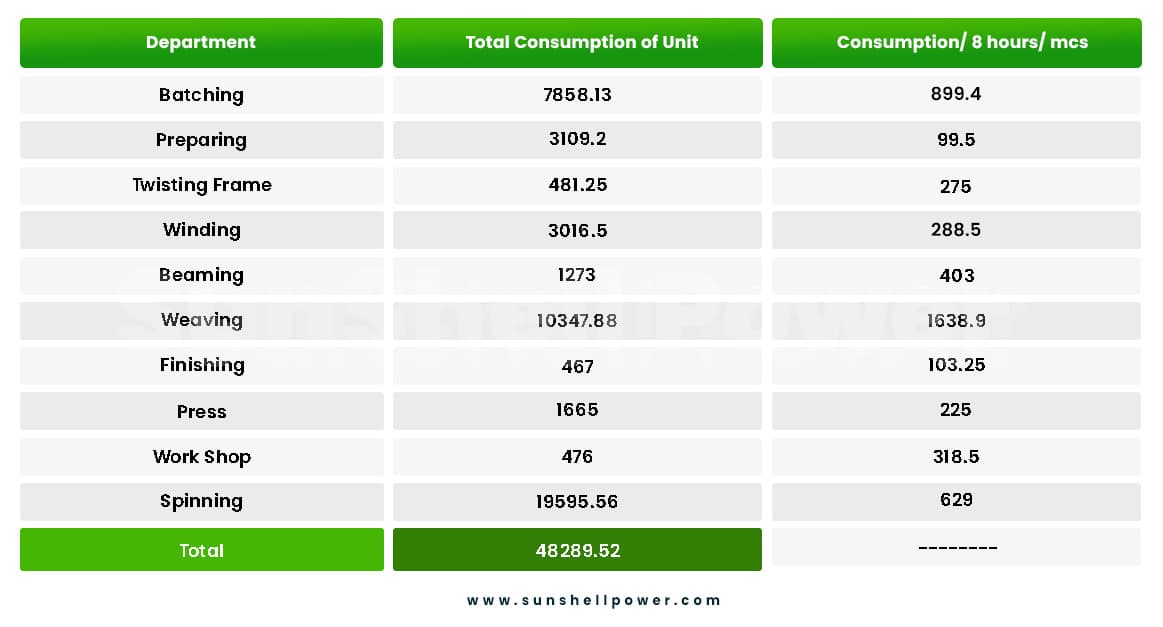
So, on an average the daily electrical consumption of a jute mill is around 48289.52 units. In jute mills, 100% run time is always the aim, which’s why so much effort is put into maintaining the reliable power supply in the jute mill. So, to run a full size jute mill solely on solar plant at least 1 mW solar plant is needed. Even though we would highly suggest jute mills to install around 500 kWp solar plants.
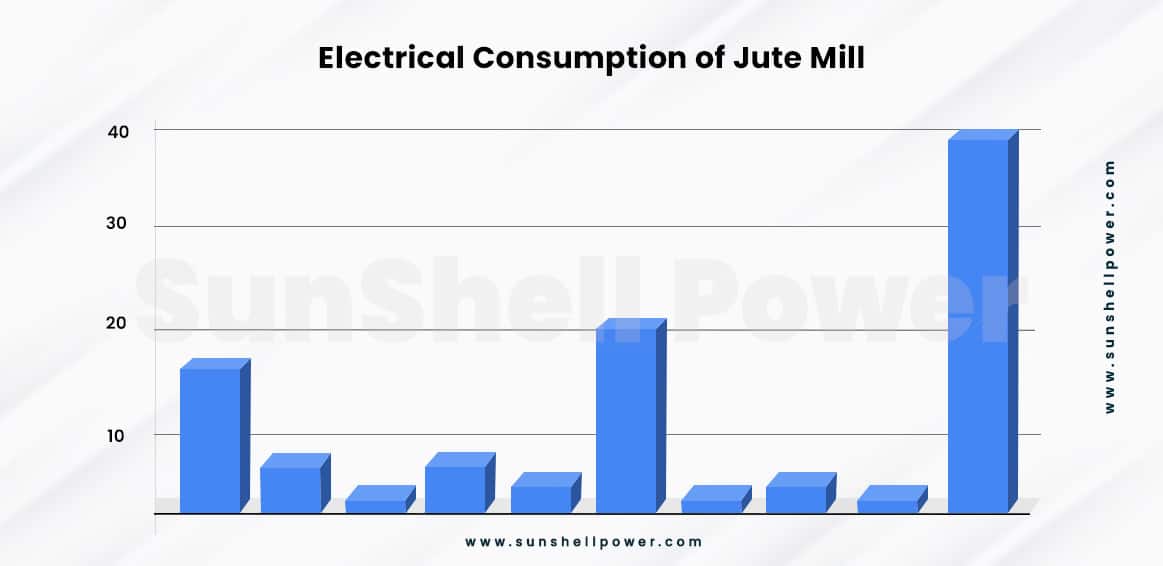
Power Backup:
As the jute mills require a huge amount of electricity for their daily operations, Diesel motors are generally used as their main power backup source.
Problems faced by Jute Mills:
Even though recent changes and steps taken by the Pollution Control Board have made people switch to decomsible jute products, the cash flow, huge electricity bills etc. has become roadblocks for the industry. Now let’s dive into the problems faced by the jute industry sector:
- Obsolete Mills & Machinery: The jute industry’s machinery is old and needs to be updated and modernized. The “Jute Technology
Mission” was created by the Indian government in 2006 to promote and expand raw jute cultivation. However, high operating costs, mostly
electricity bills, result in a shortage of capital, resulting in antiquated and inefficient gear in the jute mill. - Decrease in The Demand: Because jute items are more expensive than the competitors, demand for jute products is dwindling.
Despite the fact that several recent environmental dangers have stimulated demand on a small scale, the use of outdated technologies and procedures has resulted in high product prices. - Jute, Really A Green Option? : Even though the manufacturing process of jute strings is totally green and carbon-free, the processing of jute is harmful to the environment. During the daily operations of a jute mill around 45875.04 kg of carbon, which needs around 1400 square km of forestation for recycling.
- Shortage of Power Supply: Unreliable power supply has always been a major problem for this industry. Lack of reliable power supply has caused some major breakdowns in the spinning and whining divisions of the mill.
- More Diesel, More Cost: Because the majority of jute mills rely on diesel as a backup power source, and because power outages and fluctuations are regular, high fuel prices result in higher operating expenses for these operations.
- Higher Tariff Charges: The big industrial consumers like steel factories, cement plants, jute mills, plastic manufacturing units draw a lot of power. As the tariff charges are rising day by day, the energy cost also rises accordingly.
High tariffs and inconsistent power supply are preventing the sector from expanding and obtaining a greater market share.
So, What’s The Way Out? Solar Solutions for Jute Mills!!!
As the jute industry is always suffering from reliable power sources and high tariff charges, reliable, efficient and cost-effective power sources must be the major priority for this sector.
As technology evolves , human civilization moves towards renewable power more and more. Moreover, solar power plants are the most reliable power source among renewables. We, at SunShell Power, offer a solar rooftop solution for every problem in the steel plants. Solar modules have a life-span of 25 years with minimal maintenance which makes the plant a reliable power source.
For jute mills, we offer three types of solar solution:
- Grid-connected Solar Rooftop Plant,
- Solar Submersible Pump,
- Solar Street Light.
Grid-Connected Solar Rooftop Plant ( On-Grid):
Reliable and efficient grid-connected solar power plant with minimalistic maintenance and available net-metering facility, a credit system through banking of power. If power cuts are not frequent and for facilities with a huge load, this type of power plants are ideal.

Why On-Grid?
Even though, in SunShell Power, every solar plant is important and valuable for us, for jute mills we would highly suggest the authorities install on-grid solar power plants. From our previous experiences, we have pointed out several points from which we have declared the Grid-connected Plant to be a clear winner:
- These systems are best suitable when power consumption is really high and for cost reduction of electricity bills,
- On-grid solar systems have at most zero failure rate. So if reliable power supply is an issue, then grid-connected power plants are the best and also provides high return-on-investment,
- On-grid systems can be installed with or without net-metering,
- On-grid solar systems are very cost-effective and easy to install,
- As there is no battery backup, maintenance is minimal, which can be helpful in the busy environment of the jute mills.

Benefits of Solar Solutions for Jute Mills:
Now , the question may rise to your mind, why should I invest in solar ?
- Apart from being eco-friendly and producing green energy, solar power plants are a great financial and economical investment , which is also a reliable source of power. Here, from the feedback of our previous consumers we have listed 6 overall benefits of solar,
- Reduced electricity bills as dependency on conventional electricity & DG is reduced,
- Government gives subsidy for solar panels installations,
- Tax benefits by going for accelerated depreciation,
- Low maintenance and long life-span,
- Environment friendly solar power is the best way to preserve our planet,
- Proper utilization of the blank space on the roof shades.
Average ROI :
The average ROI of grid-connected solar plants in a jute mill is around 4-5 years; it can change based on the load, size and production capacity of the jute mill.

Alternate Solutions:
- Solar Pumps: During the retting process or during the spinning process in a jute mill, water plays an essential component. Heavy machinery used in the spinning and weaving process requires a lot of water for their operations. Solar submersible and surface pumps are the ideal for these types of usage.
- Solar Street Lights: Jute mills often cover a large area, necessitating adequate lighting for security and surveillance. Solar street lights are the ideal solution for this application. For the facilities, SunShell Power recommends two kinds of solar street lighting.
- Two-in-one (Semi-integrated): Used for a variety of purposes, these are easy to install and are low-maintenance.
- Solar Mini Mast: Best for places with unstable power sources. It uses green energy and needs almost negligible maintenance.
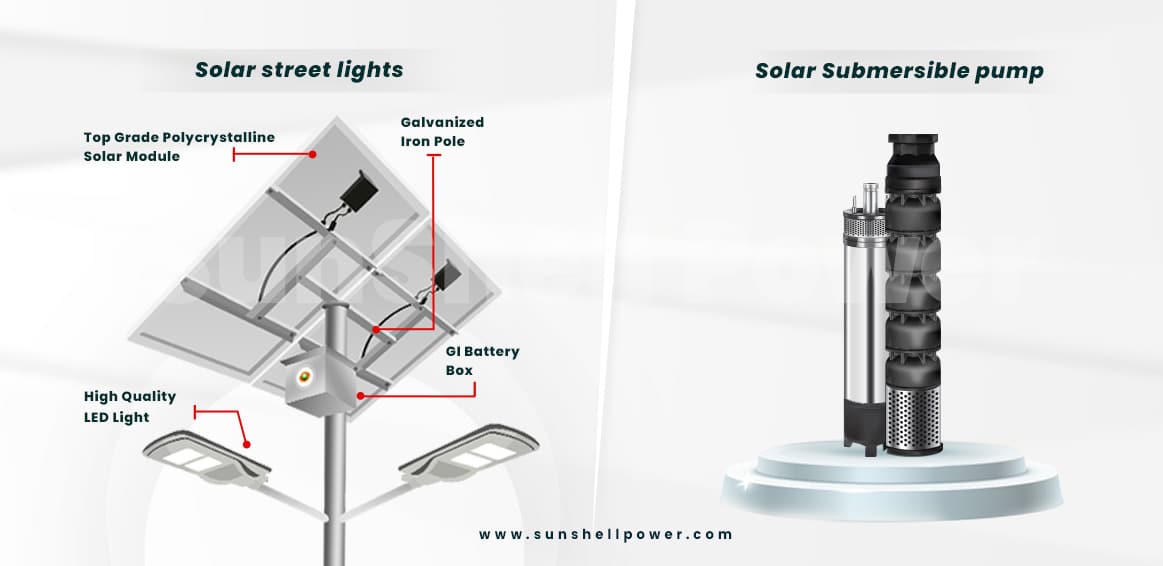
Energy Efficiency:
As per to meet the required upcoming demand in the country
and to scale the export business of this sector, energy efficiency and management of
waste heat is equally important.
Energy Audit:
Energy auditing is an energy assessment. This assessment looks at how energy flows through a structure, process, or system in order to minimize energy input while preserving or increasing human comfort, health, and safety.
According to the definition of ISO 50002 standard, an energy audit is a systematic analysis of energy use and energy consumption within a defined energy audit scope, in order to identify, quantify and report on the opportunities for improved energy performance.
There are three types of energy audits
- Walk-Through Audit,
- Energy Diagnosis,
- Investment Grade Audit
Depending on the purpose and potential savings the type of energy audit is chosen.
If the priority is to identify potential savings and further studies a walk-through audit is recommended whereas if the intention is to invest a large amount of money in energy efficiency measurement an Investment Grade Audit is done.
Benefits of Solar Solutions for Jute Mills:
- Energy auditing helps reduce costs in the facility,
- It helps reduce environmental damage and pollution,
- If any energy is active then it can be detected.
Inclination Towards A Green Future:
As the world leads towards the net-zero target, India has also set a target of net-zero by the year 2070. Govt. are offering various schemes and policies for solar installations.
Installing solar plants in jute mills is not a new concept. Many of the jute mills across India are also coming forward to reach this net-zero goal, set by the government. In the year 2012 , Auckland Jute Mills in West Bengal installed a 1 MW rooftop grid-connected captive solar plant. Recently in the month of April Janata Jute Mill, Boalmari, Faridpur in Bangladesh installed their first solar rooftop plant and expects to go fully on solar.
Enquire Now
